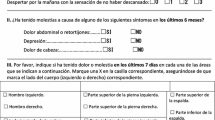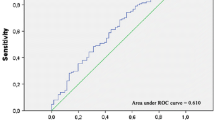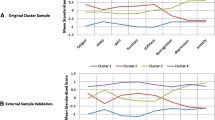Abstract
Fibromyalgia is a complex and heterogeneous disease, and several attempts have been made in order to identify different subgroups of patients sharing a common symptomatology. The purpose of the present study has been to replicate a subgroup classification proposed by de Souza et al. based in the Fibromyalgia Impact Questionnaire (FIQ) in a large sample of patients with a cultural and clinical setting different from the original one. Four hundred twenty-one patients were classified, according to the results of the visual analog FIQ subscales in type I o type II subgroups. Demographic and clinical data, as well as results of scales assessing disease’s severity, quality of life, sleep quality, anxiety and depression, were compared between the two groups. The profiles of type I and type II patients from our sample strikingly paralleled those of the original study, demonstrating the reproducibility of the classification. In our sample, 18.8% of the patients appertained to type I subgroup and 81.2% to type II subgroup. Patients from this later subgroup had higher comorbidity and received more drugs than those of the former. They were also more physically ill, with higher FIQ total scores and worse sleep quality, and more psychologically distressed, with higher levels of anxiety and depression and lower scores in the mental component summary of the Short-Form Health Questionnaire (SF-12). Our study shows that the proposed fibromyalgia classification is reliable and easy to perform and could be applied in further studies.

Similar content being viewed by others
References
Wolfe F, Smythe HA, Yunus MB, Bennett RM, Bombardier C, Goldenberg DL et al (1990) The American College of Rheumatology 1990 criteria for the classification of fibromyalgia: report of the multicenter criteria committee. Arthritis Rheum 33:160–172
Sumpton JE, Moulin DE (2008) Fibromyalgia: presentation and management with a focus on pharmacological treatment. Pain Res Manag 13:477–483
Mease P (2005) Fibromyalgia syndrome: review of clinical presentation, pathogenesis, outcome measures, and treatment. J Rheumatol 32(Suppl 75):6–21
de Tommaso M, Sardaro M, Serpino C, Constantini F, Vecchio E, Prudenzano MP et al (2009) Fibromyalgia comorbidity in primary headaches. Cephalalgia 29:453–464
Cole JA, Rothman KJ, Cabral HJ, Zhang Y, Farraye FA (2006) Migraine, fibromyalgia, and depression among people with IBS: a prevalence study. BMC Gastroenterol 6:26
Kurland JE, Coyle WJ, Winkler A, Zable E (2006) Prevalence of irritable bowel syndrome and depression in fibromyalgia. Dig Dis Sci 51:454–460
Balasubramanian R, de Leeuw R, Zhu H, Nickerson RB, Okeson JP, Carlson CR (2007) Prevalence of temporomandibular disorders in fibromyalgia and failed back syndrome patients: a blinded prospective comparison study. Oral Surg Oral Med Oral Pathol Oral Radiol Endod 104:204–216
Aaron LA, Burke MM, Buchwald D (2000) Overlapping conditions among patients with chronic fatigue syndrome, fibromyalgia, and temporomandibular disorder. Arch Intern Med 160:221–227
Bradley LA (2005) Psychiatric comorbidity in fibromyalgia. Curr Pain Headache Rep 9:79–86
Arnold LM (2008) Management of fibromyalgia and comorbid psychiatric disorders. J Clin Psychiatry 69(Suppl 2):14–19
Turk DC, Okifuji A, Sinclair JD, Starz TW (1998) Differential responses by psychosocial subgroups of fibromyalgia syndrome patients to an interdisciplinary treatment. Arthritis Care Res 11:397–404
Verra ML, Angst F, Brioschi R, Lehmann S, Keefe FJ, Staal JB et al (2009) Does classification of persons with fibromyalgia into Multidimensional Pain Inventory subgroups detect differences in outcome after a standard chronic pain management program? Pain Res Manag 2009(14):445–453
Giesecke T, Williams DA, Harris RE, Cupps TR, Tian X, Gracely RH et al (2003) Subgrouping of fibromyalgia patients on the basis of pressure-pain thresholds and psychological factors. Arthritis Rheum 48:2916–2922
Häuser W, Schmutzer G, Brähler E, Graesmer H (2009) A cluster within the continuum of biopsychosocial distress can be labeled “fibromyalgia syndrome”—evidence from a representative german population survey. J Rheumatol 36:2806–2812
Wilson HD, Robinson JP, Turk DC (2009) Toward the identification of symptom patterns in people with fibromyalgia. Arthritis Care Res 61:527–534
de Souza JB, Goffaux P, Julien N, Potvin S, Charest J, Marchand S (2009) Fibromyalgia subgroups: profiling distinct subgroups using the Fibromyalgia Impact Questionnaire. A preliminary study. Rheumatol Int 29:509–515
Hidalgo J, Rico-Villademoros F, Calandre EP (2007) An open-label study of quetiapine in the treatment of fibromyalgia. Prog Neuropsychopharmacol Biol Psychiatry 31:71–77
Calandre EP, Hidalgo J, Rico-Villademoros F (2007) Use of ziprasidone in patients with fibromyalgia: a case series. Rheumatol Int 27:473–476
Rico-Villademoros F, Hidalgo J, Morillas-Arques P, Vilchez JS, Delgado-Rodriguez A, Calandre EP (2009) An open-label study of levopromazine (methotrimeprazine) as add-on therapy in fibromyalgia management. Clin Exp Rheumatol 27(Suppl 56):S16–S20
Calandre EP, Rodriguez-Claro ML, Rico-Villademoros F, Vilchez JS, Hidalgo J, Delgado-Rodriguez A (2009) Effects of pool-based exercise in fibromyalgia symptomatology and sleep quality: a prospective, randomised comparison between stretching and Ai Chi. Clin Exp Rheumatol 26(Suppl 56):S21–S28
Calandre EP, Molina-Barea R, Morillas-Arques P, Rodriguez-Lopez CM, Garcia-Leiva JM, Rico-Villademoros F (2008) Trazodone in the treatment of fibromyalgia: a 12-weeks open label study. Int J Neuropsychopharmacol 11(suppl 1):302
Garcia-Leiva JM, Molina-Barea R, Rodriguez-Lopez CM, Morillas-Arques P, Garcia-Carrillo J, Calandre EP (2009) Ropinirole in the treatment of refractory fibromyalgia: a case series. Eur J Pain 13(suppl 1):S149
Calandre EP, Rodriguez-Claro ML (2000) A randomized, controlled-trial comparing the efficacy and tolerability of Ai Chi versus stretching in fibromyalgia management: a six-months study. In: ClinicalTrials.gov [Internet]. Bethesda (MD): National Library of Medicine (USA). 2000-[cited 2010 January 30]. Available from: http://clinicaltrials.gov/show/NCT00004451. NLM Identifier: NCT00600574
Bennett R (2005) The Fibromyalgia Impact Questionnaire (FIQ): a review of its development, current version, operating characteristics and uses. Clin Exp Rheumatol 23(5 Suppl 39):S154–S162
Buysse DJ, Reynolds CF 3rd, Monk TH, Berman SR, Kupfer DJ (1989) The Pittsburgh sleep quality index: a new instrument for psychiatric practice and research. Psychiatry Res 28:193–213
Ware JE Jr, Kosinski M, Keller S (1996) A 12-item short-form health survey. Med Care 34:220–233
Beck AT, Ward CH, Mendelson M, Erbaugh J (1961) An inventory for measuring depression. Arch Gen Psychiatry 4:561–571
Spielberger CD (1984) State-trait anxiety inventory: a comprehensive bibliography. Consultant Psychologists Press, Palo Alto
Zigmond AS, Snaith RP (1983) The hospital anxiety and depression scale. Acta Psychiatr Scand 67:361–370
Wilson HD, Starz TW, Robinson JP, Turk DC (2009) Heterogeinity within the fibromyalgia population: theoretical implications of variable tender points severity ratings. J Rheumatol 36:2795–2801
Bigatti SM, Hernandez AM, Cronan TA, Rand KL (2008) Sleep disturbances in fibromyalgia syndrome: relationship to pain and depression. Arthritis Care Res 59:961–967
Conflict of interest statement
The authors declare that they have not conflict of interest.
Author information
Authors and Affiliations
Corresponding author
Rights and permissions
About this article
Cite this article
Calandre, E.P., Garcia-Carrillo, J., Garcia-Leiva, J.M. et al. Subgrouping patients with fibromyalgia according to the results of the fibromyalgia impact questionnaire: a replication study. Rheumatol Int 31, 1555–1559 (2011). https://doi.org/10.1007/s00296-010-1521-3
Received:
Accepted:
Published:
Issue Date:
DOI: https://doi.org/10.1007/s00296-010-1521-3




